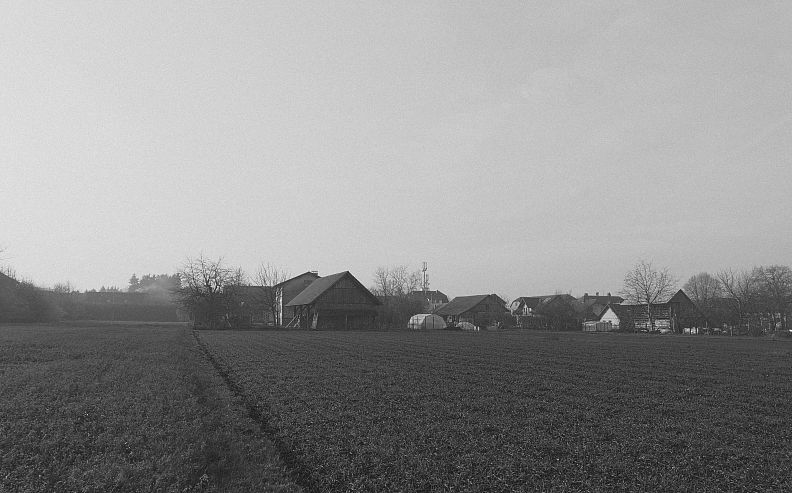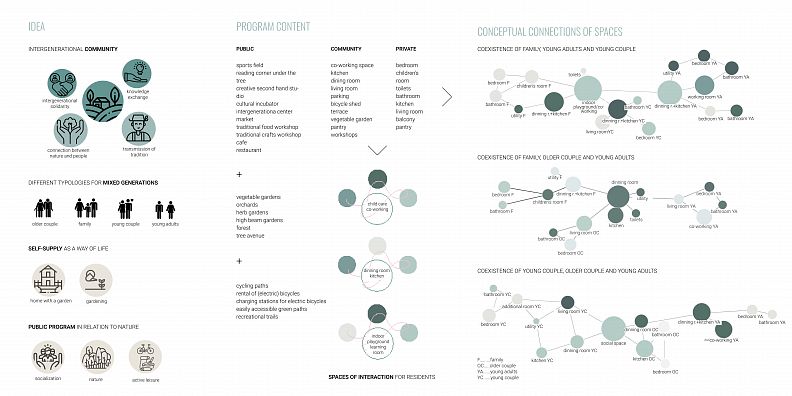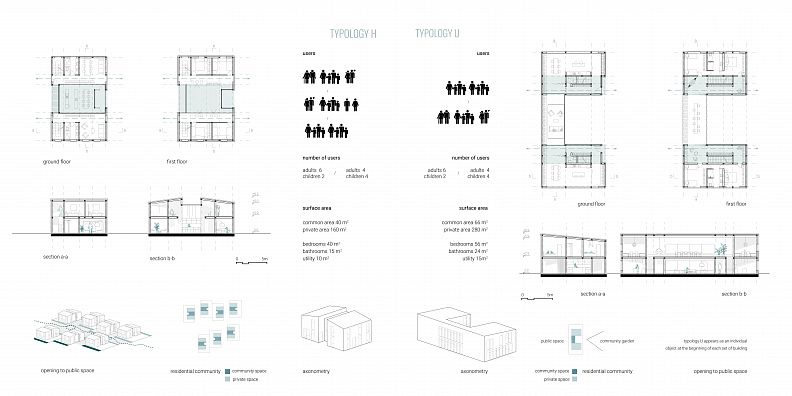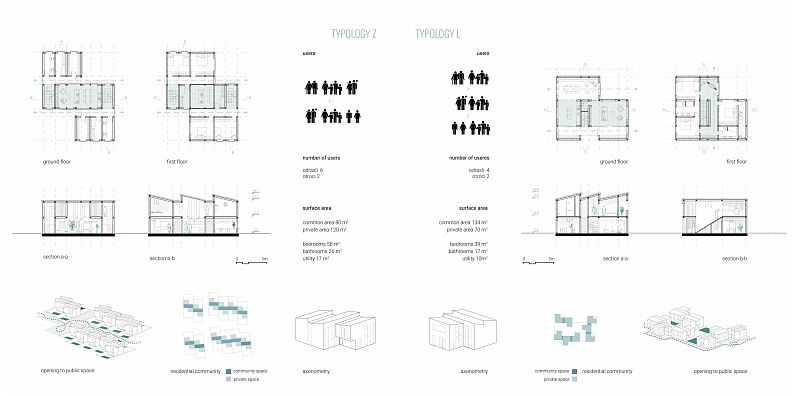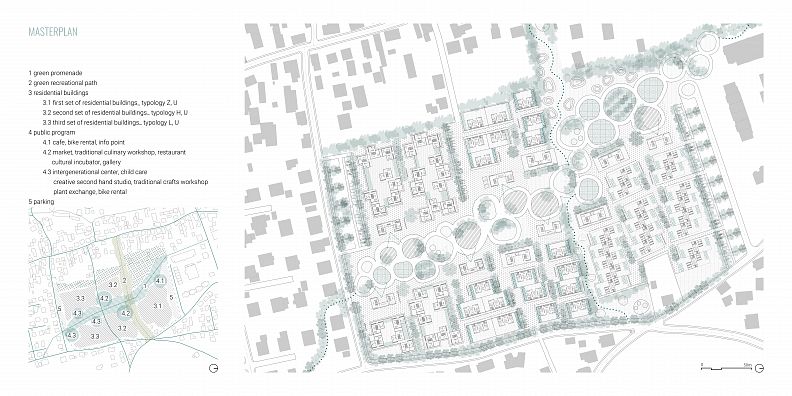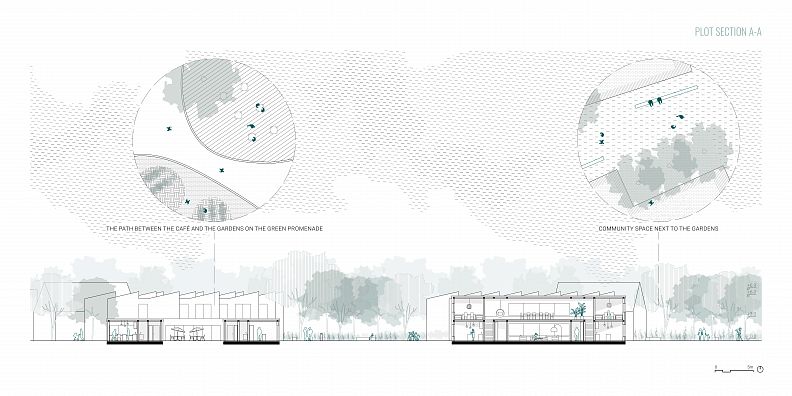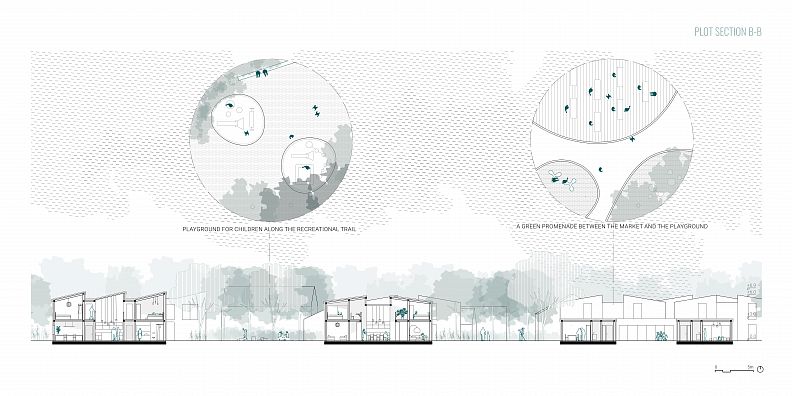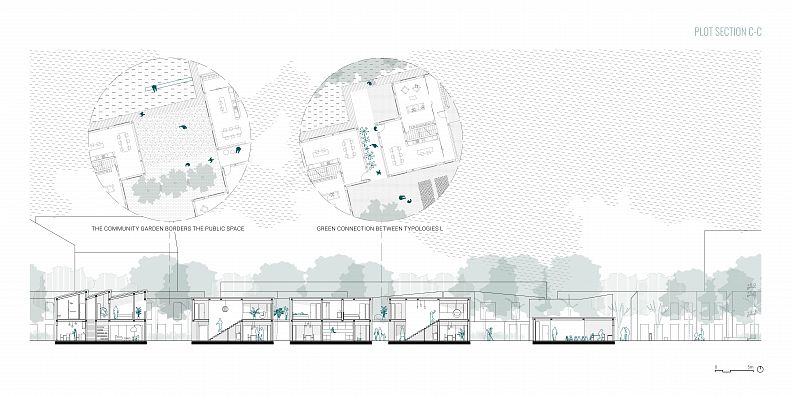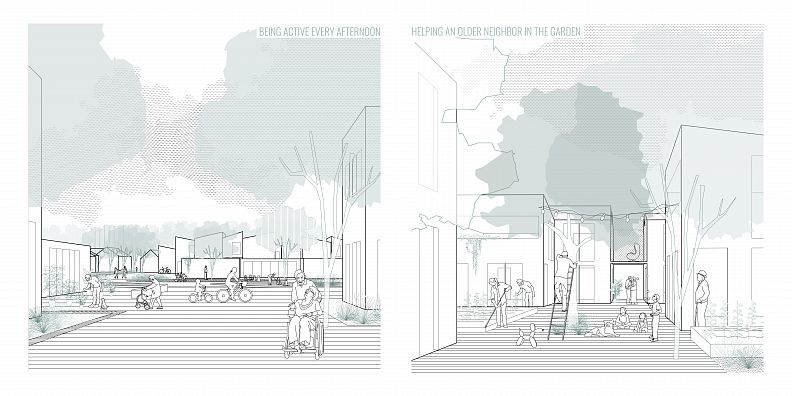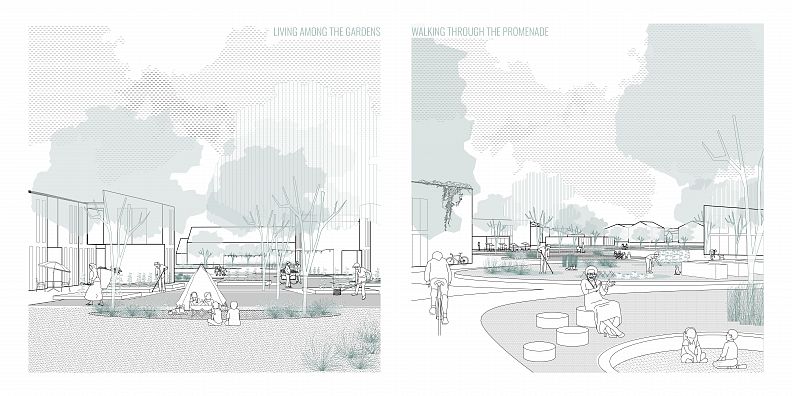Green thread

Project idea
The city is an orderly and compact urban formation with a high population density. The idea of an ideal city describes a high population density, compactness and orderliness. The clear boundary between urban and rural areas is disappearing. The city expands into a so-called suburbia or diffuse city.
With the transition from one political system to another, Slovenia has experienced many changes, including in the field of spatial legislation. The socio-economic order we know today emphasizes the importance of profit and private property. Agricultural land is changing uncontrollably into building land. Dispersion, spontaneous constructions, form and content chaos describe a suburbia that spreads uncontrollably. A fenced home with a piece of the natural edge of the city, where you have everything close to the apartment, is the ideal of living in the 21st century.
The landscaping mode supports easy car movements, pushing the pedestrian to the side. Road transport infrastructure is being built, which enables fast daily migrations, real estate prices within cities are increasing, and mass tourism is being promoted, which is slowly but surely destroying the identity of the place. More and more content is moving from cities to the periphery, where accessibility by car is easier. Shopping malls create ideal places for consumers.
We build an undefined space ‘in between’ that creates our identity. The solutions are in condensing, reconstruction of monofunctional areas into multifunctional, sustainable concepts, creating a new centrality of the program, program diversity, raising the quality of architecture.
It is becoming clear that the countryside has a growing potential for further spatial development. With innovative, sustainable interventions that mean the regeneration of degraded areas and with shared awareness, we can restore the diversity of life and identity to the countryside that has been lost in past processes.
In this perspective, it is also important to consider the role of the older generation, the intergenerational connection of old and young. An idea that takes us to a time when the Slovenian area was made up of the majority of the population engaged in agriculture. The extended family consisted of the so-called basic cell and homestead. Intergenerational connections, cooperation and mutual assistance have established themselves as key values for survival.
Today, young people are moving to urban areas where there are more activities and better employment opportunities. The elderly remain in the countryside without additional activities, which often leads to illness and loneliness. Care for the elderly is largely left to the competent institutions, which are overcrowded.
Cooperation between generations, between young and old, can make an important contribution to creating a more empathetic society, to the transfer of tradition, skills and knowledge that would otherwise be lost over time. With modern ways of coexistence of generations, we want to introduce coexistence among the residents. With selected content, it creates a space of interaction that contributes to a more integrated life of young people and activation of the elderly.
Project description
The given location is located in the immediate vicinity of the center of Šentjernej, south of the main road - Prvomajska road. The area in question is represented by arable land and meadows, which extend east of the existing roadside construction along the western side, along the October victims road. According to OPN Šentjernej, the area is intended for residential use.
The spatial design continues the pattern and geometry of the existing built structures in the immediate vicinity. The building proposal takes into account and relates to the landmark on the northern edge, drawn by higher apartment blocks south of Prvomajska road, the low building of the Spar store, the municipal building, the school and the kindergarten. Single-family houses line the road on the west side of the site, while gardens and arable land are located on the east side of the plot. In the southern part of the location of the apartment house also lined along the road.
An important landmark in the space is also the chapel, which is located in the eastern part of the location. The Franciscan cadastre shows the important spatial geometry of the path created by the inhabitants of Šentjernej to the neighboring villages. It ran from the center of Šentjernej, diagonally across fields and meadows, towards the villages of Dolenja Stara vas, Dolenja Brezovica and Volčkova vas.
The spatial design clearly connects and highlights important existing and historical connections in the space, with a landscaped north-western entrance to the site, along the path towards neighboring villages past the existing chapel to the east. In the transverse direction, both connections are maintained as the main veins for powering the neighborhood and the public program. The path that runs from north to south - the green promenade, is a public path, along which a variety of activities for residents and occasional users. The promenade is a mix of paved paths, green islands for play and recreation, paved platforms and common gardens and orchards. Along the path are ground-floor buildings in the shape of the letter U, with public contents that open onto a green promenade.
The arrangement situation shows three different ambient constructions, each following the geometry of the surrounding space. Individual buildings are determined by the selected typology of residential buildings, including various semi-detached spaces belonging to a smaller community. The central part of each building is a common space intended for interaction, socializing and coexistence of residents.
A clear gradation is created between the public, semi-public and private, both in spatial planning and in the architecture of buildings. Encouraging interaction between the residents of the new neighborhood and the residents of Šentjernej is one of the key goals. The regulation introduces a focus, a liaison program and activities that encourage the participation of all generations.
Technical information
ARCHITECTURAL DESIGN
The basic guidelines in the design of the building typology are
intergenerational integration and self-sufficiency in the countryside. Reflection on the potentials and problems of the countryside leads to the idea of coexistence, the economy of division and coexistence between generations. Topics that dictate the composition of spaces that users / residents can share. Users are diverse, families, older couples, young couple and young employees. The design of typologies allows for common activities, contents that are the common denominator of all generations. Common areas such as a shared kitchen, living room, large work table, conservatory, atrium and garden are the central spaces of each typology. These also include the composition of private, more intimate spaces.
Each typology is different depending on the square footage of private and common spaces. On the ground floor, in all typologies, there is a larger space where residents can socialize. This is connected to the garden and further to the outdoor market, which is intended for the wider community. The connection between the living room and the community square is open and important as it emphasizes a sense of connectedness.
TRAFFIC REGULATION
The location is limited at the edges by road. The October Victims' Road in the west and Kotar's Road in the east are intended primarily for cars and connect the center of Šentjernej with the villages in the south. The location is divided by a one-way road that connects the said road.
The sustainably designed neighborhood has adapted space movement and traffic arrangements. Parking lots are arranged north and south on site. The neighborhood area is for pedestrians and cyclists only. An intervention route and car access for elderly residents is planned between the buildings. Residents can leave their personal car in the parking lot at the edge of the location and walk to their home. The one-way road that intersects the location is maintained and along it is added some additional parking spaces, especially for the disabled and bicycle sheds.
The green promenade is a paved sandy path for pedestrians and cyclists. Across it runs the Green Trail, a recreational green area intended primarily for pedestrians. More walking and cycling promotes a healthy lifestyle, more interaction with others and a step forward towards nature conservation.
With the aim of establishing a bicycle as the main means of transport in the neighborhood, Šentjernej and its surroundings, a bicycle rental is also being set up. Bicycle sheds and electric bicycle charging stations are located next to the car park and public buildings.
LANDSCAPING
Between the existing building and the new neighborhood, a ‘green barrier’ is created with clusters of trees delimiting the space of the green promenade and the private gardens of single-family houses.
Along the recreational Green Trail are planted clusters of trees, artificially designed terrain with play hills, islands with playgrounds for children, recreational aids and places to relax.
The green promenade is built by a paved path with sand, islands of common gardens, orchards, paved platforms intended for various activities related to public facilities, green islands for relaxation and playgrounds for children.
The tree-lined avenue separates the residential neighborhood from the road and parking lots in the northern, eastern, and southern parts of the site. The tree-lined avenue is both an acoustic and a visual barrier.
GREEN THREAD
Today, young people are moving to urban areas where there are more activities and better employment opportunities. The elderly remain in the countryside without additional activities, which often leads to illness and loneliness. Cooperation between generations can make an important contribution to creating a more empathetic society, to the transmission of traditions and knowledge that would otherwise be lost over time. With modern ways of coexistence of generations, we want to introduce coexistence among the residents.
The spatial design of the neighborhood highlights important existing historical connections in the space, with a landscaped northwest entrance to the site, along the path to neighboring villages past the existing chapel to the east. In the transverse direction, both connections are maintained as the main veins for powering the neighborhood and the public program. The path, which runs from north to south - the green promenade, is a public path, along which a variety of activities for residents and occasional users. The promenade is a mix of paved paths, green islands for play and recreation, paved platforms and common gardens.
A clear gradation is created between the public, semi-public and private, both in spatial planning and in the architecture of buildings. Common areas such as a shared kitchen, living room, large work desk, atrium and garden are the central spaces of each typology. These also include the composition of private, more intimate spaces.
